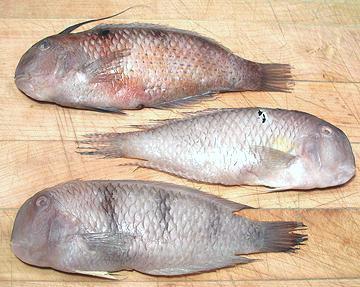 [Iniistius baldwini alt Xyrichtys baldwini of family Labridae
(wrasses)]
[Iniistius baldwini alt Xyrichtys baldwini of family Labridae
(wrasses)]
This is a Pacific fish, ranging from the Pacific side of Sumatra through Hawaii to the Gulf of California and along the tropical west coasts of North, Central and South America. It is found most intensely around Borneo and the north central coast of Australia, but ranges as far north as the southern tip of Japan.
This is a small fish. The largest in the batch was about 7-1/2 inches long and weighed 2-7/8 ounces, about as big as they get. This fish is amazingly thin, the 7-1/2 inch fish being only 0.7 inches thick. Colors and patterns varied but most had the black and white spot displayed by the center specimen.
I presume the large fancy colored one with the top knot is a male. The male of most animal species is flashier to attract females - except for humans. The reason is, as any marriageable woman will tell you, there are plenty of males but not so many suitable as mates, so the competition is fierce. Unfortunately, most human females are irresistibly attracted to men that aren't the most suitable - probably obsolete hormones. Razorfish and other wrasses, incidentally, change sex during life, with the most successful individuals ending up as dominant males.
More on theWrass Family.
Razorfish have a white, mild but distinct tasting flesh that remains quite firm during cooking. Cooking and eating them does provide some challenges, though, as explained below.
Cooking: Here we run into some unusual problems. Dusted with rice flour and fried, you will find the flesh so firm it's difficult to disassemble on the plate. Could we fillet it? Not advised. It's remarkably difficult to fillet - too much effort for so small a fish and the skin shrinks so strongly the fillets will curl up into a tube before you even get to turn them skin side down.
Well then, we could poach them - but a normal 8 minute poach leaves the flesh still way too firm. I suggest poaching or steaming for 20 to 25 minutes Then you will have a delectable little morsel that's not too challenging to eat.
Eating: I find the best way to eat these fish is with pointy Japanese style chopsticks - the Chinese ones are too blunt and clumsy. As with other tiny long-finned fish, you need to be careful not to break up the fins as you remove the flesh. With a little practice you will end up with a bare skeleton with fins intact top and bottom. A light, simple sauce of lemon juice, white wine and butter is ideal for this kind of fish.
Buying: There is no razorfish fishery, so you can't just go out and buy them. They're something you may come across accidentally, most likely in a market serving a Philippine community.
Scaling: This fish is completely covered with scales that are very large for the size of the fish, but they're thin and scrape off easily with very little flying about.
Cleaning: Should you wish to cook these "head on", you would need to pull the gills with small long nose pliers, and they don't pull at all easily. Their attachment is much stronger than the gills, which just break up into small pieces.
I suggest cutting off the head. Make one cut on each side behind the pectoral and pelvic fins and use kitchen shears to cut through the backbone. Pull the head off, then split the belly and scrape out what little didn't come off with the head.
Skin: The skin is very thin and would be very difficult to remove, but this is not necessary. Skin shrink during cooking is extreme, making fillets impractical even if you had the patience to fillet this fish (not easy).
Yield: A 7-1/2 inch fish weighed 2-7/8 ounces. Cleaned and head removed it was 2 ounces (70%). After eating, 0.38 ounces remained, so the edible yield was 1.62 ounces (56%) which is pretty good yield, especially for a fish that cost me 2010 US $1.99/pound.
sf_razorz 100925 - www.clovegarden.com